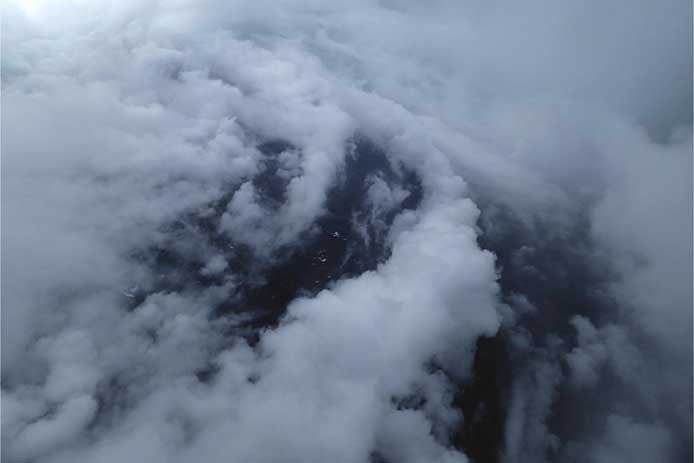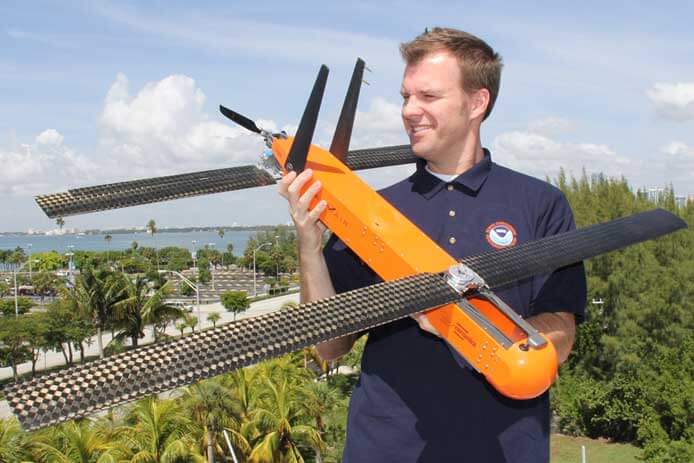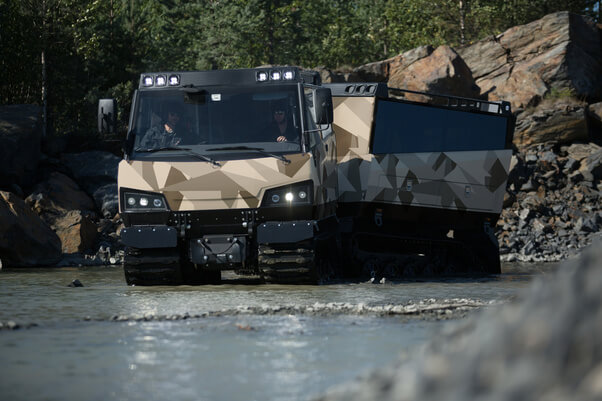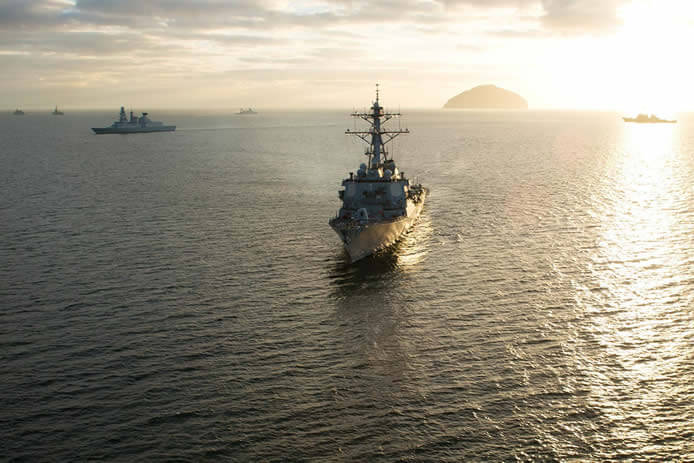
Into the Eye of the Storm
Image: Clouds swirl at the eye of Hurricane Edouard in 2014. The storm marked the first use of Raytheon's Coyote unmanned aerial system as a weather-forecasting instrument. (NOAA Photo)
Taking the risks
Coyote is a remote-controlled airplane that steps in when the job is too risky for manned aircraft. It hunts submarines. It takes surveillance images. It assesses combat damage. And now, it sizes up hurricanes. To do that, Coyote drops out of a P-3 weather surveillance plane and flies straight at them, braving violent winds and punishing rain to gather weather data and beam it back to meteorologists.
Raytheon experts in Tucson, Arizona, are developing the Coyote's forecasting capabilities alongside the National Oceanic and Atmospheric Administration and National Hurricane Center. Traditional weather instruments parachute from a plane and grab only a snapshot of humidity, wind speed and other factors, but Coyote's winged design enables it to linger and return to certain areas for more measurements.
“Coyote can fly for over an hour, at least 50 miles from its host aircraft, and into the lower altitudes where the P-3 is not safely allowed – below 2,000 feet in altitude – to gather and transmit data from the most intense area of the storm,” said John Hobday, Raytheon business development lead for unmanned systems.
The system is a recent addition to Raytheon’s family of high-tech weather forecasting technology, including the Visible Infrared Imaging Radiometer Suite instrument aboard NOAA’s Suomi NPP spacecraft, and the Advanced Weather Interactive Processing System, a powerful analytics tool that helps meteorologists make sense of the massive amounts of weather data that modern sensors collect.
Breaking the boundaries
Coyote solves a problem that has long limited forecasters’ ability to tell how hard a hurricane will hit. The secret behind the storm's punch lies in what is known as the “boundary layer” – a low-altitude area that includes the surface of the ocean.
 NOAA scientist Paul Reasor holds Coyote, an unmanned
NOAA scientist Paul Reasor holds Coyote, an unmanned
aircraft that flies into severe storms to collect weather
data for meteorologists. (NOAA photo)
“That’s where the energy is extracted from the ocean to the atmosphere,” said Joe Cione, a NOAA hurricane researcher. “Unfortunately, it is too difficult for us to go with manned aircraft to fly down there.”
The best way – until now – was to use small, expendable sensors called dropsondes that plummet out of a plane and take quick measurements on their short-lived fall to the surface.
Coyote takes a different approach. It rides aboard the P-3 inside a three-foot-long, five-inch-wide tube called a sonobuoy. When the plane gets close enough to the storm, the tube drops out of a chute, and Coyote spreads its wings and springs into action.
Clouds swirl at the eye of Hurricane Edouard in 2014. The storm marked the first use of Raytheon's Coyote unmanned aerial system as a weather-forecasting instrument. (NOAA Photo)
Coyote takes off
NOAA has already put Coyote to work. In 2014, the agency deployed four of the planes into Hurricane Edouard, a Category 3 storm. Scientists on board the P-3 received meteorological data in both the eye of the storm and the surrounding eye wall.
“Coyote will gather data specifically in the eye wall, or in the areas on the verge of the eye wall, where it can provide information for forecasters to predict intensity from a safe distance,” Hobday said. This is a significant difference for researchers: instead of providing a snapshot of data, it’s a “full-length movie.”
Engineers at Raytheon and the NOAA Aircraft Operations Center have upgraded Coyote’s sensor systems and improved its communications package to allow it to talk to the plane over longer distances, said Andrew Osbrink, Raytheon’s Coyote program manager.
“The P-3 will be able to place the Coyote in the storm and continue on its mission without stopping or doing anything related to Coyote and continue doing the rest of their hurricane mission, undisturbed, and still receiving Coyote data at all times,” he said. “This is a much better and much more efficient use of time and resources.”
For Cione and his colleagues, Coyote is a critical tool that allows them to accomplish their mission.
“At the end of the day," Cione said, "my job is to use science, knowledge and my abilities to save lives and protect property."













